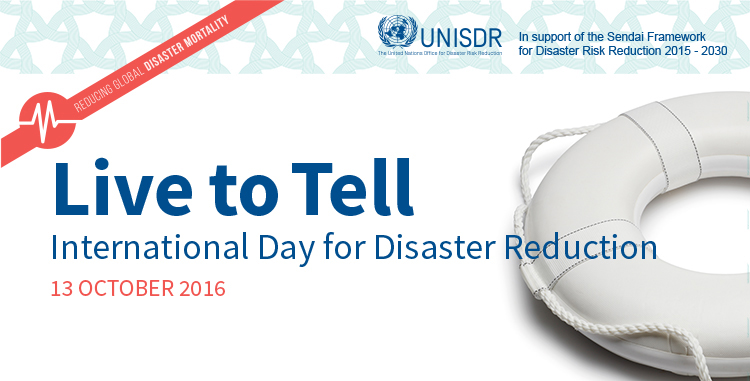International Day for Disaster Reduction 2016
Live To Tell Campaign: Raising Awarenesss, Reducing Mortality

“Everything can be rebuilt, but lives cannot be recovered, and that's what hurts the most," - President Rafael Correa, Ecuador, after the April 2016 earthquake that killed 661 people.
Goal: Use International Day for Disaster Reduction on 13 October 2016 to:
Provide an advocacy platform for all governments, local governments, disaster management agencies, UN agencies, NGOs, Red Cross and Red Crescent societies, civil society groups, businesses, academic and scientific institutions, and other interested groups to demonstrate support for implementation of the Sendai Framework and to highlight achievements and challenges in so doing with a particular focus on life-saving measures in 2016;
The 2016 campaign will seek to create a wave of awareness about actions taken to reduce mortality around the world. UNISDR wants you to use the opportunity of October 13 to tell the world what you are doing to implement the Sendai Framework in order to reduce mortality and improve health outcomes from disasters.
Are you improving how people are becoming more risk informed? How are you doing it? Have you become more inclusive in your outreach with early warnings?
EXAMPLE: Following what may be Canada’s costliest disaster, the Fort McMurray fires earlier this year, the Canadian Forest Service proved the case for generating fire risk maps as a reliable tool for ensuring safe evacuation in fire prone areas or designating such areas as unsafe for human habitation.
EXAMPLE: This year the Pakistani city of Karachi has opened 179 heatstroke centres to keep down the death toll from heatwaves which killed over 1,000 people last year.
EXAMPLE: The governments of Australia, Canada, France, Germany, Luxembourg and The Netherlands have agreed to give more than US$80 million to equip up to 80 countries with better climate risk early warning systems.
EXAMPLE: Unicef and the Children in a Changing Climate coalition have developed the Sendai Framework for Disaster Risk Reduction: for children. It is a great educational tool for children exposed to disaster events.
EXAMPLE: In May 2016, WHO established a new Health Emergencies Programme designed to deliver rapid, predictable, and comprehensive support to countries and communities as they prepare for, face or recover from emergencies caused by any type of hazard to human health, whether disease outbreaks, natural or man-made disasters or conflicts.
We will share your stories, photographs and videos online through our social media channels, on the UNISDR website and PreventionWeb. Please send submissions to [email protected].